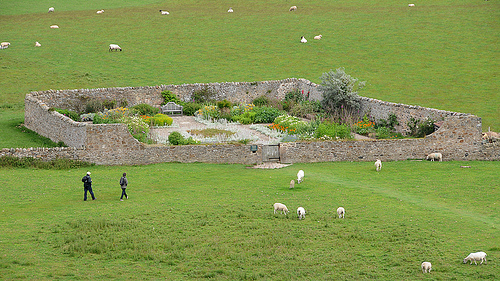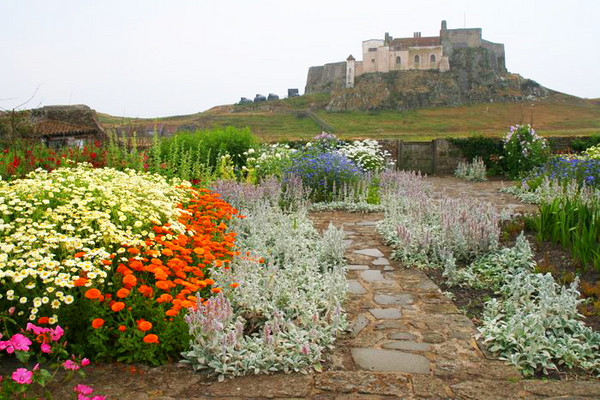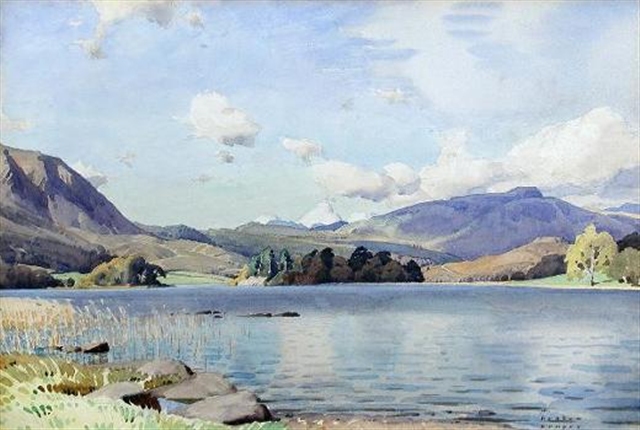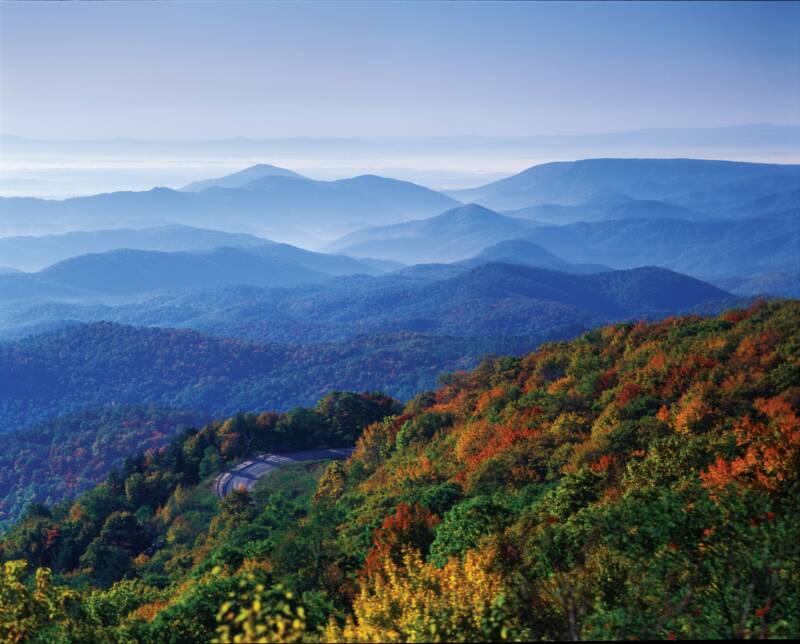 Do Laurel and Hardy have something to teach us about colour perspective? The words of garden designer Gertrude Jeckyll seem to confirm the words of the American comedians.
Laurel and Hardy sang about the blue-ridged mountains. But were they seeing blue mountains or green mountains in Virginia?
Do Laurel and Hardy have something to teach us about colour perspective? The words of garden designer Gertrude Jeckyll seem to confirm the words of the American comedians.
Laurel and Hardy sang about the blue-ridged mountains. But were they seeing blue mountains or green mountains in Virginia?
When learning to paint landscapes I was taught the principles of colour perspective. In a natural landscape those parts that are in the distance look bluer. Artist use this to indicate distance. A good gardner understands, along with the landscape painter and the this too. Just as with a painter, the gardener is creating a beautiful scene and will consider the combinations of colour so that the whole scene is harmonious. When considering how distant flowers will combine with those that are closer, he must take into account the fact that everything looks bluer when it is further away.
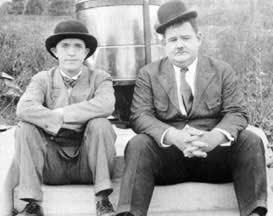 There is a another way of making use of this. If I want to enhance the sense of space I can create artificial perspective. The gothic architect made the distant objects smaller in reality, so that it doubles the natural effect of perspect and made things seem even further away than they are. Consequently, gothic cathedrals seem to soar to heaven. The gardener can use large-leaf plants closeby and small-leaf plants in the distance, so creating the illusion that things are further away than they really are. Similarly he can put bluish green leaves and blue flowers in the distance and other colours in the foreground and it will reinforce this further. It is useful if you have a small garden but want to create a sense of greater space.
There is a another way of making use of this. If I want to enhance the sense of space I can create artificial perspective. The gothic architect made the distant objects smaller in reality, so that it doubles the natural effect of perspect and made things seem even further away than they are. Consequently, gothic cathedrals seem to soar to heaven. The gardener can use large-leaf plants closeby and small-leaf plants in the distance, so creating the illusion that things are further away than they really are. Similarly he can put bluish green leaves and blue flowers in the distance and other colours in the foreground and it will reinforce this further. It is useful if you have a small garden but want to create a sense of greater space.
Even when we know this it is not always easy to see it. When we focus on a distant point, the mind modifies the information that the eye supplies it to create an image in our mind's eye that is affected by what we know, or think we know, to be true. So looking at distant hills that are blue tinged we don't believe that they are really blue, the brain knows that they are in the distance and we very often see it as green.
Gertrude Jeckyll was a garden designer who used her artistic training in the academic method in the choice of planting. She describes here how she convinced a skeptic of the fact that things in the distance really do look blue:
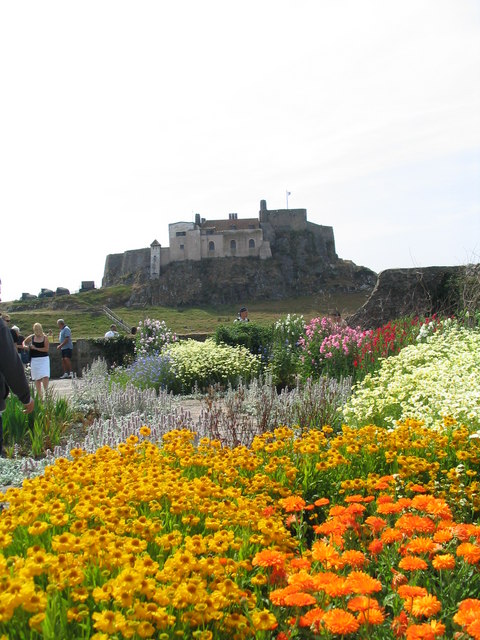 'As for the matter of colour, what is to be observed is simply without end. Those who have not training in the way to see colour nearly always decieve themselves into thinking that they see it as they know it is locally, whereas the trained eye sees colour in due relation as it truly appears to be. A remember driving with a friend of more than ordinary intelligence who stoutly maintained that he saw the distant wooded hill quite a green as the hedge. He knew it was green and could not see it otherwise till I stopped at a place where part of the face, but none of the sky bounded edge of the wooded distance showed through a tiny opening among the near green branches, when to his immense surprise he saw it was blue. A good way of showing the same thing is to tear a roundish hole in any large bright-green leaf, such as a Burdock and to hold it at half arm's length so that a distant part of the landscape is seen through the hole and the eye sees the whole surface of the leaf. As long as the sight takes in both it will see the true relative colour of the distance. I constantly do this myself, first looking at the distance without the leaf frame in order to see how nearly I can guess the truth of the far colour. Even in the width of one ploughed field, especially in autumn when the air is full of vapour, in the farther part of the field, the newly turned earth is bluish-purple, whereas it is rich brown at one's feet.'
'As for the matter of colour, what is to be observed is simply without end. Those who have not training in the way to see colour nearly always decieve themselves into thinking that they see it as they know it is locally, whereas the trained eye sees colour in due relation as it truly appears to be. A remember driving with a friend of more than ordinary intelligence who stoutly maintained that he saw the distant wooded hill quite a green as the hedge. He knew it was green and could not see it otherwise till I stopped at a place where part of the face, but none of the sky bounded edge of the wooded distance showed through a tiny opening among the near green branches, when to his immense surprise he saw it was blue. A good way of showing the same thing is to tear a roundish hole in any large bright-green leaf, such as a Burdock and to hold it at half arm's length so that a distant part of the landscape is seen through the hole and the eye sees the whole surface of the leaf. As long as the sight takes in both it will see the true relative colour of the distance. I constantly do this myself, first looking at the distance without the leaf frame in order to see how nearly I can guess the truth of the far colour. Even in the width of one ploughed field, especially in autumn when the air is full of vapour, in the farther part of the field, the newly turned earth is bluish-purple, whereas it is rich brown at one's feet.'
So it seems that Laurel and Hardy could have been landscape painters, or gardeners - each had an artists eye!
Images: the Appalachians in Virginia; the garden scenes are of a small walled garden on Holy Island, in the Farne Islands of the coast of Northumberland in England. This designed, to some degree, to be seen from the bench seat visible below. The wall protects the garden from high winds. I struggled to find photographs of her planting that illustrate very strongly the principles I have been describing, but though the photos of this garden would be of interest to readers anyway!; the watercolours below are by John Singer Sargent and W. Heaton Cooper the 20th century English painter respectively.

